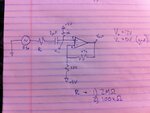mjxshipton
Newbie level 5
I'm in a bind. I'm working on one of several major projects - a small radar system for my antennas class. Thing is, the hardest parts went easy, the ramp generator and active LPF. I'm on the last low-frequency part, a simple gain stage, and something is amiss.
I've attached the schematic. They say to assemble the gain stage - thus 3 resistors, a cap and one op amp out of a MAX414 - and test it. It's in a non-inverting setup with a +5VDC bias. I've attached the relevant schematic.
I get nothing out of it. This has been plaguing me for about 5 hours. The LPF, which also uses the MAX414, works fine. But the gain stage gives me nothing.
I'm testing it with a 5Vpp + 5VDC offset sine wave, about 1-8kHz. I've measured both inverting and noninverting pins and output. On the output, I typically get "~1V." On the inverting pin, for a while I was getting ~4V, but now it seems to be giving me the positive cycle of the noninverting pin. Either way the output is still nothing. I even replaced the suggested capacitors with all 10ks to give me a simple gain of 2, but still nothing. At this point, I'm baffled. I have tried making the amplifier on the other pins, nothing, on anohter board, nothing. The active LPF still works fine.
I simulated the circuit in PSPICE, works completely fine. But real life isn't being so agreeable.
Would you happen to have any suggestions?
View attachment proj_schematic.pdf
I've attached the schematic. They say to assemble the gain stage - thus 3 resistors, a cap and one op amp out of a MAX414 - and test it. It's in a non-inverting setup with a +5VDC bias. I've attached the relevant schematic.
I get nothing out of it. This has been plaguing me for about 5 hours. The LPF, which also uses the MAX414, works fine. But the gain stage gives me nothing.
I'm testing it with a 5Vpp + 5VDC offset sine wave, about 1-8kHz. I've measured both inverting and noninverting pins and output. On the output, I typically get "~1V." On the inverting pin, for a while I was getting ~4V, but now it seems to be giving me the positive cycle of the noninverting pin. Either way the output is still nothing. I even replaced the suggested capacitors with all 10ks to give me a simple gain of 2, but still nothing. At this point, I'm baffled. I have tried making the amplifier on the other pins, nothing, on anohter board, nothing. The active LPF still works fine.
I simulated the circuit in PSPICE, works completely fine. But real life isn't being so agreeable.
Would you happen to have any suggestions?
View attachment proj_schematic.pdf

